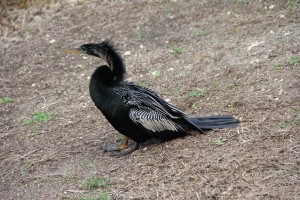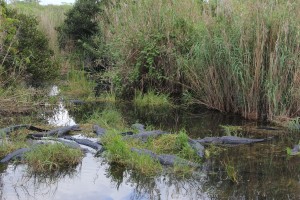Anhinga Trail — A Walk That Can Be As Subtle As Night And Day
By Kaitlyn Carroll
Day and night; dark and light; quiet and loud. In Everglades National Park, the Anhinga Trail has two different faces. The area welcomes visitors to experience both the loud, bustling day and the quiet, eerie black night.
The trail entrance at the Royal Palm Visitor Center sits on the southern tip of Florida, towards the eastern edge of what Linda Friar, spokeswoman for Everglades National Park, calls one of the nation’s more subtle parks. “It takes a little more energy to experience,” she said. The 1.5 million acre park offers hiking, biking, canoeing, camping, fishing and more to the adventure-minded tourist. “It was the first national park set aside for biodiversity. The number of different habitats, the number of species; you can see this geography is no other place on Earth,” Friar said. The Anhinga Trail is a miniature model of the park’s abundance of natural beauty.
A small group gathered around the trailhead one recent spring night. The Anhinga Trail starts as a winding pathway along the bank of a sawgrass marsh and turns into a wooden boardwalk as it extends out onto open water. The loop out and back takes a leisurely twenty minutes.
The constant hum of mosquitoes and the chirping of crickets chorused amid the occasional birdcall. Those who forgot bug spray cursed under their breath. People scanned the water with flashlights until one beam swept across the glowing eyes of a large American alligator. The others gathered to watch as it rippled towards the nearest bank, where fish seemed to be jumping.

Photo by Kaitlyn Carroll
While the Anhinga Trail remains open 24 hours a day, many visitors who explore after dark choose to do so during a guided night tour. Park Ranger Linda Coldiron began the tour by asking everyone to keep his or her flashlights off during the first few minutes of the walk. The group started down the trail, and as everyone’s eyes adjusted to the sheer darkness the loudest sound was the shuffling of shoes on the pavement. People whispered and bumped shoulders. Even Coldiron whispered as she elaborated on the history of the park.
When she gave permission to turn on flashlights, people quickly began to scan the water for more signs of alligators. However the day had been cooler and overcast, and Coldiron explained that nights like that did not usually produce many sightings. Someone spotted something in the water – a Lilly pad. But then, a gator. It quickly submerged before everyone could find it with their thin beams of flashlight. Coldiron apologized for the scarcity of reptiles. She assured that a day trip would make up for the night’s flop.
The following brought promise, sunshine, and warm, calm air. The parking lot was full and there was a constant stream of cars in and out. It was loud and busy and bright.
Tourists, especially families, enjoy the Anhinga Trail during the day because “it’s always got a lot of wildlife,” Friar said, and “it’s easy access for all ages.”
Along the opening of the trail, double-crested cormorants sat four in a row on a wooden railing, their deep turquoise eyes watching quietly as tourists came within inches. Near the line of trees on the other side of the walkway, a large Florida softshell turtle scooted across the grass. When people came too close, she backpedalled and kicked out her hind legs. A purple gallinule weaved his way through the tall grasses along the edge of the water and an anhinga, the snake-necked bird after which the trail is named, sat high in a tree with his wings spread wide, warming himself in the sun.
Tourists, talking loudly, took pictures. The plop of Florida redbelly turtles ducking into the water and the calls of birds could be heard among many voices. It is the quietest animal, however, that is the Anhinga Trail’s main attraction. A few could be spotted inconspicuously sunning along the embankment as the trail moved along. Other park guests, walking back from the far end of the trail, hinted that the best was yet to come.
It was – the alligators Coldiron promised.
A pit full of them. The end of the boardwalk opened up into a small observation deck, where dozens of alligators sprawled across the muddy ground below. At first they seemed tangled; knots of tails and legs combined. But a closer look revealed a large reptilian puzzle. Each piece fit snugly together but maintained its own edges. Some were submerged in the water until only their snouts and the spines on their backs were visible. Others lay out on the grass with their legs extended to each side. Many had their eyes closed, seemingly oblivious to the masses of onlookers above. But the few with their eyes open seemed to be staring right back. They were so close, yet so far away; far enough for the visitors not to show fear.

Photo by Kaitlyn Carroll
People called out a count, but each number was different. The lengths of the alligators, too, seemed to be a topic of debate. A young boy guessed 30 feet. His father corrected him to 10. Female alligators often do reach 10 feet in length, while males reach up to 15 feet on occasion. While the alligators in this hole seemed to enjoy their distance, many others do come closer. Gators occasionally cross the Anhinga Trail path or sun themselves where the pavement is warm.
“The gators walk across, and we’re finding people sitting their young children on top of the gators,” Friar said. “I’m not kidding…they think that they’re not real because the gator just sits there.”
There has only been one case of a human/gator interaction in the park, according to Friar. “That was a child who rode a bike over it and fell on the gator, and the gator snapped. The child was fine.” Friar suggested that a new type of fencing might be introduced to prevent further interactions like that one.
Whether they are two feet or two hundred feet away, the daylight allows tourists to keep a comfortable distance. Some say the attraction of Everglades National Park is subtle, but between day and night at the Anhinga Trail, the natural beauty of South Florida is very clear.